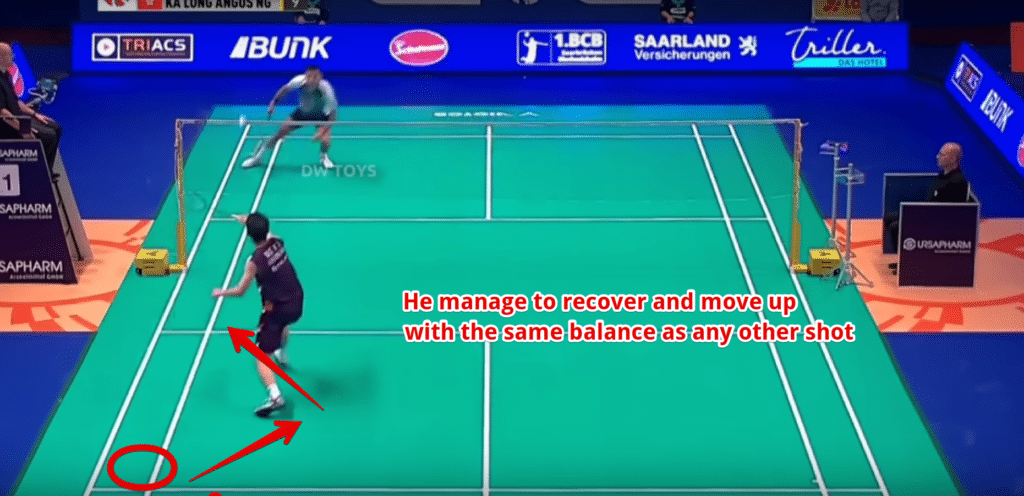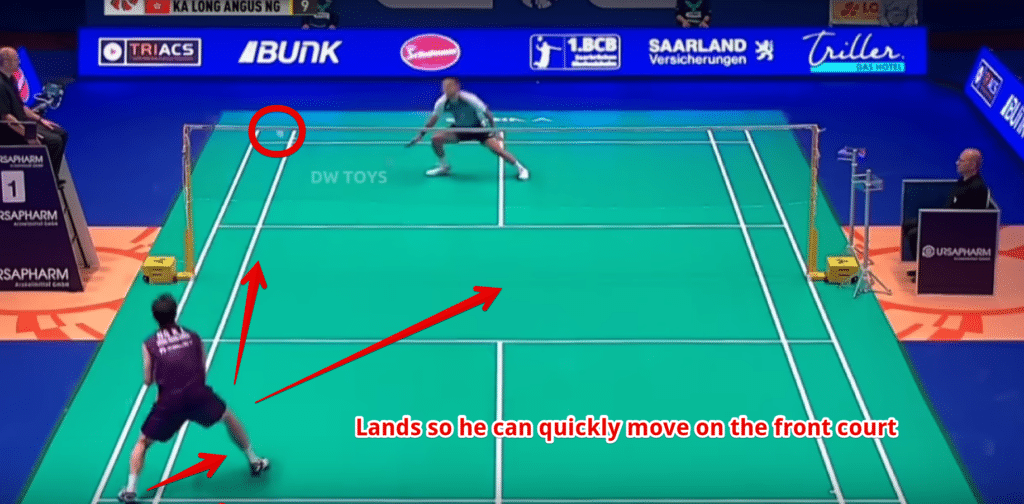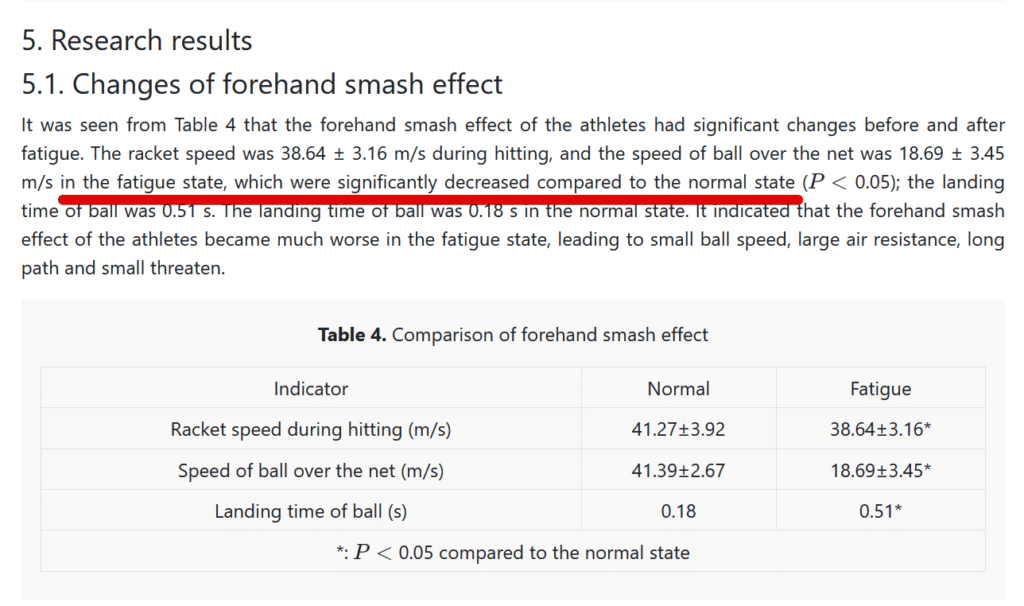Everyone loves to watch professional players jump at the shuttle as limber and elegant as a cat, smashing it down with a vibrant strike. The high-pitched sound of the racket strings hitting the shuttlecock and sending it at the opponent’s court like a bullet is nothing short of exciting – but do you have the right idea about playing this shot?
The badminton jumping smash looks cool. It’s mesmerizing to watch. But do we get fooled by its allure?
How often have you seen someone try to hit a jump smash, and get it horribly wrong with their timing, positioning, and technique?
I see it every single week at my club.
They either hit it into the net or graze the cork on the racket frame.
And that’s just everyone else – how often have you done it?
I know I’ve been guilty of trying to hit these jump smashes – when you see the shuttle go over your head, it’s like you’re salivating at the temptation of jumping up to hit a point winner – but I often end up “eating feathers” and falling all over the court.
That’s not how it has to be. Your game could improve if you don’t bet everything on one shuttlecock to try and finish a rally. It’s not only about practice, as you might think. It’s more about when and where you use it.
Is the badminton jump smash the holy grail, or are you desperate for point winners?
Anyone who plays in semi-professional or amateur clubs has thought about how they can deliver a deadly smash consistently.

Even though you might view this shot as a “point winner” after watching professional players hit spectacularly shuttles this way, it’s only a half-truth when you take a closer look.
Far too often, a jump smash in badminton actually ends up losing you points – especially for club players.
Look at this jump smash into the net.
It’s not that you shouldn’t practice this technique at all, but it seems that too many players put this shot on a pedestal as their most powerful weapon to win a quick point when it probably has to be a much smaller part of their game.
It’s important to know whether you need to hit a jump smash, or if you’re doing it because you think it’s cool.
How strong is the badminton jumping smash?

A lot of people online (and offline, for that matter) will try to tell you that a jump smash is one of the best ways to finish points because you can jump up, get a steeper angle on the shuttle, and bring more speed and power into your shot. How could that not be a point winner?!
The problem is that most players don’t realize how technical the shot is.
It requires perfect timing and positioning to create any real threat to your opponent. On top of it, you’re putting a lot of energy into making it a point-winning shot which leaves you vulnerable if it doesn’t win you the point.
“Hulk smash!” hitting winners AND losers
Have you ever considered how often jump smashes actually end up in winning points?
If you’ve ever seen “Moneyball” by Bennett Miller (a movie about how statistics changed the game of baseball), there’s a parallel to be drawn on how we view the jumping smash in badminton.
In baseball, everybody loves to see a home run. That one big hit instantly puts a point on the board, and there’s nothing the other team can do about it.
However, when going for that big hit, there are also a lot of misses. The vast majority are big fat missed opportunities. What wins the most games is every other play that happens consistently, every time.
In Moneyball, they figure out that over a season, those big hits don’t matter as much as everything else.
Still, nothing draws you in like a home run. In badminton, this is easily the jumping smash.
No other shot looks as spectacular even though it’s more of a hail mary – you might win the point, but most of the time, you don’t. Sometimes you even lose on it.
Unfortunately, there aren’t any good statistics about the percentage of jumping smash points, even from professional tournaments – and certainly not on the club and amateur levels.
Instead, I’ll give a few real match examples, which you can see countless times in all the big tournaments.
If we look at professional players that hit a jump smash, they don’t always turn them into winning points.
Here, Ratchanok Intanon plays a jump smash and quickly moves in with a strong hit on the weak return shuttle to keep the pressure on and win the rally in three strikes. The jump smash is used more as part of a pressure combo.
Here’s another one. After a perfect jump smash opportunity, Kenta Nishimoto moves on the return shuttle the moment he lands his jump. He doesn’t assume the shot will be a point-winner.
Here’s that same situation, this time against Anders Antonsen. Nishimoto quickly recovers and is ready to return a net shot only moments after a jumping smash from the rear court.
What’s happening with all these smashes?
Firstly, you see how often the jumping smash is returned, and how often it’s returned without much effort.
Keep in mind this is it when it comes to the badminton jumping smash.
Even the losers here would be absolute assassins on any club level. The game isn’t played at a higher level than this, and they execute the jumping smash correctly almost every time.
Most other badminton players (like you and I) don’t.
Secondly, they don’t even seem to be using this as a “point winner” every time, but rather to put pressure on a follow-up shot that could win instead.
Again, this is still very hard to do even for advanced players.
Here are some examples from different club players on different levels.
Notice how the first jump smashes don’t win points. They’re hit back with little effort. Only the last jumping smash, where the opponent isn’t in a great defensive stance, becomes a winning point.
In this clip, the jump smash doesn’t win the point, but the following drive shot does.
Here a player tries a jump smash out of position and isn’t able to catch the return shuttle (which luckily for him, is returned by his partner from the backcourt).
None of these players are in any way, bad badminton players.
Still, when watching good club players, one of the first things you notice is how difficult this shot technique is. Even on the jumping smashes, where they seem to get most of the timing and position right and connect well with the shuttle, it’s still defended relatively easily.
The wide-open badminton jumping smash can backfire and mess up your game
Bad positioning and timing ruin your jump

This is probably the most common mistake when trying to hit a badminton jump smash.
Returning on lifts and clears are some of the luring shuttles where a thought enters your mind in a split second – “Maybe if I quickly step over and jump, I can hit a good smash to finish the rally…”
We think this, even when we have to move backward and sideways to get far enough behind the shuttle to strike it with enough power and accuracy that it becomes a deadly threat to our opponent.
Even when the shuttlecock isn’t that high in the air and a standing shot would be better.
Even when it has so much speed that it will reach the backcourt and is almost impossible to get behind, we still think that we can jump up and smash it.
It’s like someone waving a free point before your eyes – or so you think.
Hitting a jumping smash in badminton is more of a quick evaluation shot that requires the right position and timing, rather than something you can whip out as a thoughtless reaction shot.
Ideally, your position for a jump smash is when you can easily split step to get just behind a high shuttle, so your jump and stroke lean into the shuttle, instead of trying to extend your racket behind where you rely too much on wrist movement.
It’s incredibly difficult to reach a shuttle in a jump smash when you’re not positioned to jump at it with the right timing.
What ends up happening is that you jump awkwardly in one direction and stretch yourself to hit the shuttle.
Trying to hit when you’re in a bad position with bad timing often ends up like this (smashing into the net).
Out of balance is out of touch
Without perfect technique, there’s a big margin for error in your jump smash.
Without even considering whether you’ll hit the shuttle well, you risk landing out of balance and might need an extra second to recover and get back in position and ready stance.
Anyone who’s ever played a single set of badminton knows that an extra second on the court means the shuttle is already coming back at you before you’re ready to return it.
Most of the time, this will result in a lost point or, at the very least, a weak return on your end because you’re out of balance with your weight distribution all wrong, locking up your footwork.
Because jump smashes aren’t guaranteed point winners, you need to recover effectively after your jump if you want to be ready to follow up on the next shuttle.
Take a look at this video clip in slow motion (three jumping smashes in a row).
Notice how Kunlavut Vitidsarn lands out of balance, specifically on his second jump smash. As he jumps on the third smash, he’s so out of balance and position that he hits it into the net.
What matters here is landing in a stance where you can keep your footwork intact to reach whatever shot your opponent sends back.
Another example shows how being “in balance” after a jump smash might be the only thing that lets you return the shuttle when you don’t score a winning point.
Play this in slow motion.
The attacker hits a powerful and well-placed jumping smash. Lakshya Sen defends the smash and manages to return a shuttle on the net. This shot would be almost impossible to follow up on without proper recovery after the jump.
Pay close attention to the footwork and stance. Notice how Ng Ka Long Angus recovers after his jump smash. He lands in a wide stance so he can go immediately into a split step and move on the front court.
His legs aren’t too close or too low to restrict his movement. He’s recovered fully to move in any direction on the court.


Do you see how much technical skill goes into the jumping smash when we’re not even considering hitting the shuttle accurately?!
Other than the risk of being out of balance after hitting a jump smash, this spectacular athletic shot also requires a lot of energy.
You’ll gas out quicker than a “humvee”
If you keep seeking out the jump smash, even in the smallest opportunities, it doesn’t take long before you feel fatigued creeping up on you.
Think about how often you’ve played a match that you wished you could’ve finished in the second set, that instead goes into the third. There’s no doubt that your performance will be lower here, compared to the first set.
You don’t reach as many well-placed shuttles, you don’t hit with the same accuracy and power, and you don’t move as fast around the court.
Using a lot of jumping smashes in your game is one way to help fatigue set in much earlier.
There was a study on badminton players’ smashing performance, which shows how significantly fatigue decreases performance.

Of course, this is no surprise to any badminton player. We know that fatigue is one helluva factor when it comes to performance. It clouds your mental focus and puts a damper on your physical abilities.
This is where you’ll start making more mistakes in recovering your position to return the next shuttle. Both in your overall performance and also making it even harder to jump smash at a golden opportunity in a later rally.
Since the jumping smash is one of the most strenuous strikes you can hit, you might want to consider the strategic complications of using it too often – unless you have a “third lung” in later sets.
Here’s a perfect example of Kodai Naraoka gassing out and losing a rally. He hits a jumping smash around seven times without getting close to a point winner – around the 50-second mark, he’s completely fatigued.
Takeaways
- A jump smash in badminton is often more of a gamble than you think because they rarely end as “winning points.” When the shuttle is returned you can quickly end up under pressure to recover and strike it back – pressure your opponent didn’t do anything to create
- Professional players don’t assume winning points from a jumping smash. They use it just as often (or more often) as part of their pressure play that sets up a winning point, in the following strikes
- What happens after you hit a jump smash is just as important as hitting the shuttlecock correctly. If you land out of balance, you risk not being able to strike a good return on the next shuttle
- By limiting your jump smashes to the best opportunities, you can put more pressure on your opponent, avoid losing too much stamina for later sets, and hit more point winners
Do you think you’ve been trying to win points by going for a jump smash too often? Would your game improve if you limited yourself from this shot unless you’re in a good position?
Quick questions about the jump smash in badminton
A jump smash in badminton is when you jump at a shuttle and hit a forehand stroke above your head. The primary function of this technique is that your jump allows you to hit the shuttle with high speed onto your opponent’s court, at a better and steeper downward angle than you would a normal smash.
When you do happen to be in a position to hit a jumping smash and win a point (or at least add a pressure element), you can learn the right form and practice to make it happen in this article.
There are no rules against jumping in badminton. If you prefer, you can bounce around like a rabbit as much as you’d like.
Typically the only time it’s beneficial to jump is when you’re in a good position to hit a jumping smash that can send a fast shuttle at a steep angle at your opponent to either win a point or put them under tremendous pressure to defend.